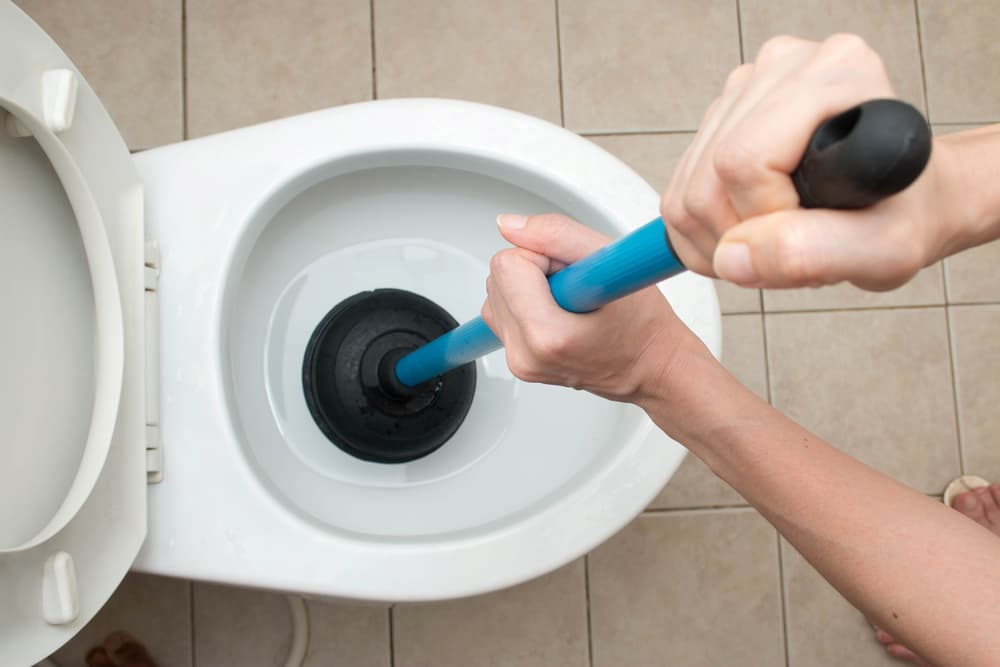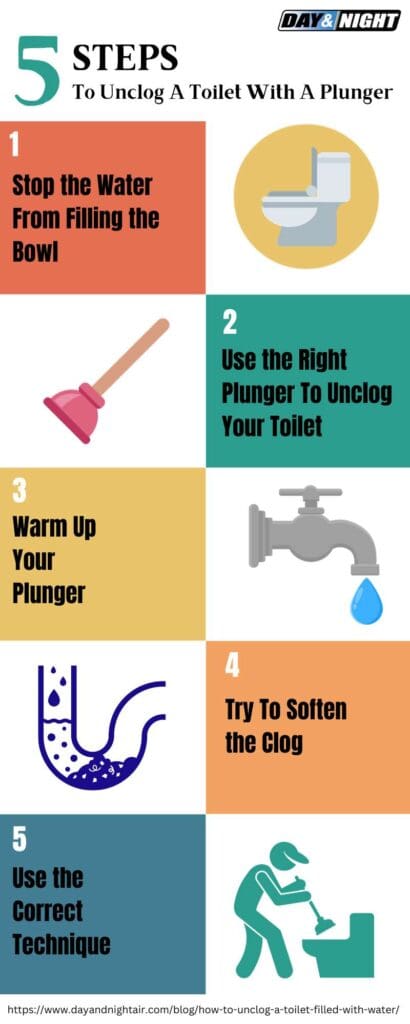If you find your clogged toilet won’t drain, and you’ve been wondering the best ways to unclog it yourself this blog will teach you:
- DIY steps to try in a pinch when trying to unclog a toilet.
- What to avoid when trying to unclog a toilet and why.
- When you should call a professional plumber for a clogged toilet.
Nothing can send you into a panic quite like when you have a house full of people, and your clogged toilet won’t drain. So when faced with a blocked toilet filled with water, what do you do? Don’t worry; you aren’t alone. In Phoenix, AZ, and surrounding valley areas, Day & Night Air Conditioning, Heating & Plumbing is here to help. There are a number of different DIY tricks you try first to unclog your blocked toilet and if these don’t work then you can always give us a call. We would be happy to come assist you with all of your plumbing needs. 602-956-9404
How To Unclog A Toilet With A Plunger
You may not realize that using a plunger effectively means using the right type and technique. If time is of the essence and you want to eliminate the clog yourself, take these steps to ensure the best outcome when it comes to unclogging a toilet that is full.
1. Stop the Water From Filling the Bowl
You know the feeling: the dread, the panic, and the impending doom as you watch a toilet fill with water and everything else you expected to go down the now clogged drain. Don’t stay frozen in fear. Move quickly to stop the water from filling the bowl by taking off the tank lid. Find the flapper and push it down quickly to stop the water from flowing from the tank to the bowl before turning off the water valve.
2. Use the Right Plunger To Unclog Your Toilet
Now that you’ve averted an embarrassing and messy flood, it’s time to pull out the plunger. Hopefully, you’re already equipped with the best type of plunger for clearing a clog. The best one is a funnel-cup style. But, regardless of the style, the key is getting a good seal between the plunger and bowl.
3. Warm Up Your Plunger
Your plunger is relatively stiff in its natural state. But what you need is for it to conform to the shape of the bowl more readily. The easiest way to do this is by warming the plunger in hot water for a few minutes before using it. More flexible rubber will seal better over the drain.
4. Try To Soften the Clog
To get the best results, try softening up the clog before you start plunging. Here are a couple of techniques using items found in most households:
- Soap and Hot Water - Remove some of the water in the toilet with a cup or bowl to make room for adding about a gallon of water. Put a soap dish, shampoo, or slivers of bar soap in the bowl. Then heat a gallon of water to the temperature of hot tea, pour into the bowl, and wait about 20 minutes.
- Baking Soda and Vinegar - Try a safe chemical reaction. Measure one cup of baking soda and pour it into the toilet bowl. Then, slowly pour in one cup of vinegar. The fizz may help to break up the clog before you even have to plunge. Even if it doesn’t, it is safe to plunge after trying this combination.
5. Use the Correct Plunger Technique For Unclogging Your Toilet
There is a proper technique to use when plunging a toilet. First, ensure it is sealed over the drain. Then plunge down and firmly back up. The pullback motion is equally as important as the downward motion.
After a few strokes, hopefully, the clog will be dislodged, and the water will rush from the toilet bowl. If so, you can safely turn the water back on and try to flush the toilet normally. If not, you may have a bigger problem that goes further back in the plumbing. That tells you it is time to call in the professionals.
Here’s How To Unclog A Full Toilet Without a Plunger - 4 Home Remedy DIY Options
Although a good plunger is typically the preferred method for dealing with a clogged toilet sometimes it’s not possible to use one. If your toilet is so full of water the plunger will cause a spill, or you don’t have a plunger handy. When either of these scenarios is the case there are other options for unclogging a toilet without a plunger. Many are similar to the steps mentioned above when using a plunger.
- Use Dish Soap To Unclog a Toilet - The slippery nature of dish soap can help to lubricate the pipes from the grease-cutting power of the dish soap has the ability to break down wads of toilet paper which could be the cause of the clog. Pour ½ a cup of dish soap into your toilet bowl, if possible add a gallon of hot (but not boiling) water as well to help activate the clog-busting ingredients in the dish soap. Wait 20 minutes and then try out a test flush. You might need to scoop some of the water out with a cup or bowl to accommodate the hot water.
- Use Shampoo To Unclog a Toilet - Although not as effective as dish soap, shampoo can also be used in the same manner as dish soap to try to break up a clogged toilet. For this method, you will also need to pour about ½ a cup of shampoo into your toilet, add hot water, and wait 20 minutes before flushing.
- Use Baking Soda To Unclog a Toilet - Something a little stronger than dish soap for dealing with a clogged toilet is a baking soda/vinegar combination. Pour 1 cup of baking soda and 2 cups of vinegar into your toilet. It will begin to fizz but this is okay. Let it sit for about 30 minutes and then try a test flush.
- DIY (Do-It-Yourself) Coat Hanger Drain Snake - Sometimes clogs are just too stuck for a liquid method to work. When this is the case and you are in a jam (pun intended) you can try grabbing a metal wire coat hanger and untwisting it until you have a straight section. Carefully thread it down into the toilet to see if you can hit the blockage manually. If you do then slowly work the hanger back and forth to see if you can break up the clog.
If these home remedies don’t do the trick then it’s time to call an experienced plumber in your area to help you unclog your toilet.
What Not To Do When Trying To Unclog A Toilet
Before attempting to clear the blockage, know there is one thing every professional will warn against. You may be tempted to try a commercial drain cleaner marketed as a clog buster. Do not do this! There are several reasons why:
- Drain cleaners have a high concentration of corrosive chemicals like lye and sulphuric acid. These chemicals can be dangerous if inhaled, ingested, or come in contact with the skin.
- The chemicals can damage plumbing if overused. Not only can it corrode pipes and sink traps, but it can dissolve rubber gaskets or adhesive in pipe joints.
- If you attempt to plunge in standing water that also contains drain cleaner, the chemicals could splash on you, potentially causing burns or even more severe injuries.
Now that you know what not to do, let’s explore what you can do to clear a blocked toilet filled with water safely.
Call a Professional Plumber Near You
When your best DIY efforts aren’t working, it’s time for professional intervention. Besides the clog that won’t budge, other signs that your DIY efforts won’t work are seeing water back up into tubs or showers when you flush. That could indicate there is a problem with your main line.
A professional plumber near you has the experience to look for and recognize the symptoms that indicate likely sources of your problems. They also have the training, tools, and equipment that help to diagnose your plumbing blockages. Their methods can include some or all of the following:
- Pipe cameras - The only way to see what is going on in plumbing under slabs or behind walls is by using a camera. Pipe cameras give an internal view of what is happening inside the pipes. This tells them if there is a root, a crushed line, or other types of obstruction. Understanding what they are dealing with helps them know what tool or technique is best for the job.
- Manual drain snake - The drain snake is a long cable with a corkscrew-type end. The plumber will insert the end into the drain then crank it through the pipe until they dislodge the clog.
- Motorized drain snake - A motorized drain snake is similar to the manual drain snake, except it is powered by a motor for very large pipes or stubborn clogs that have resisted other techniques.
- Drain auger - A drain auger is similar to the drain snake. It is usually used on sinks or small drains. They can also be manual or motorized.
- Hydro-Jet - The hydro-jet uses pressured water to break down buildup in drains and pipes. It can be used for periodic pipe cleaning or removing the toughest blockages. The hydro-jet is faster and more efficient than other techniques and can also work as a preventive measure to avoid future clogs by cleaning off buildup within the plumbing.
- Cable cleaning - Cable cleaning machines have a cable with sharp spinning blades on the end to cut through blockages. It is less messy than drain snakes.
Day & Night Air Conditioning, Heating & Plumbing Is Your Trusted Plumbing Professional
If you ask your friends and neighbors in Phoenix, Arizona, and surrounding valley areas, who they can trust for honest, dependable service, the answer is Day & Night. Our team of professional plumbers near you have the training, experience, and expertise to handle your most challenging problems. Whether you need HVAC service, plumbing, or drain clearing, we will be there for you. For fast, efficient, and friendly service, contact us today.
Featured Image: Jones M/Shutterstock


